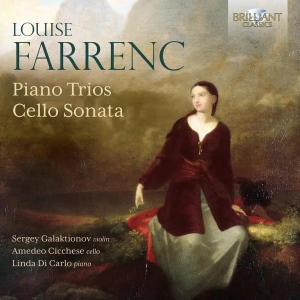
Louise Farrenc (1804-1875)
Piano Trio No. 1 in E flat major, op. 33 (1843)
Piano Trio No. 2 in d minor, op. 34 (1844)
Cello Sonata in B flat major, op. 46
Linda Di Carlo (piano), Sergey Galaktionov (violin), Amadeo Cicchese (cello)
rec. 2022, Studio Piano et Forte, Perugia, Italy
Brilliant Classics 96352 [76]
Slowly, we are starting to get more recordings of works by women composers of the 19th century, among them Cécile Chaminade, Emilie Mayer, Amanda Maier, Fanny Mendelssohn and Louise Farrenc. I would venture that the latter is the most broadly talented of them all, having composed works well beyond the salon, where many of her contemporaries were forced by convention to remain. Not only did she compose chamber music, but also three symphonies (review), and most significantly, was appointed Professor of Piano at the Paris Conservatoire in 1842, an almost unheard-of appointment at the time.
The two trios presented on this recording are the only two Farrenc wrote for the “standard” combination of piano, violin and cello. There are two others, where the violin is replaced with a wind instrument. While they are consecutive opus numbers, and written less than a year apart, they are quite different in their feel, structure and influences. The first, in four movements, has a Beethovenian feel, with a jaunty opening in the strings that contrasts with a flowing piano melody. The slow movement has a melancholy atmosphere, and does tend to outstay its welcome. The Menuetto looks backwards, but is well-constructed and enjoyable, while the Finale rounds off the work in great style; it may be the best of the four. While the second trio is described in the booklet notes contributed by pianist Linda Di Carlo as “more forward-looking”, the second movement Theme and Variations has definite hints of Schubert’s Trout Quintet, and the Rondo finale brings to mind Mozart’s Piano Concerto K466 (also in d minor). Nevertheless, the work still feels as though it has an original voice.
The Cello Sonata was new to me, and relatively scarce in the catalogue: this is only the third recording. It too has hints of Beethoven and Schubert, and illustrates Farrenc’s innate talent for melody.
This recording is one of only two in the catalogue to provide Trios 1 & 2. The other is a Centaur disc from 2016, which I reviewed very negatively. So unless this new Brilliant Classics release is awful, it becomes the go-to choice for getting both works on the one disc. And I’m pleased to say that it isn’t remotely close to awful. Taken overall, I enjoyed the performances, finding them full of character. They aren’t perfect; I found the playing at times to be a little too heavy-handed, and felt the more rounded Linos Ensemble’s recording of the E flat major trio (review) more appropriate for the work’s elegance. The sound is very bright, which did the violin’s tone no favours at times. The booklet notes provide reasonable biographical and musicological information, with the glaring exception that the Cello Sonata is completely ignored.
If you already have the Linos Ensemble’s recordings, you may feel that you can keep your credit card in your wallet, but if you don’t, this is a good and inexpensive way of getting to know the trios of this underrated and under-recorded composer.
David Barker
Help us financially by purchasing from




















